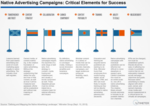8 Critical Elements of Successful Native Advertising
Altimeter Group has just released a new report entitled, Defining and Mapping the Native Advertising Landscape. Authored by Altimeter Group advertising analyst Rebecca Lieb, the report attempts to define native advertising and examines what it dubs the "advertising triumvirate" or publishers, technology vendors and social media platforms.
The report defines native advertising as follows: Native advertising is a form of converged media that combines paid and owned media into a form of commercial messaging that is fully integrated into, and often unique to, a specific delivery platform.
The report also points out the varied benefits of native advertising to various participants in the industry:
- For publishers, new forms of premium inventory
- For social platforms, new advertising products
- For brands, new opportunities for attention, engagement and message syndication
- For agencies, benefits from creative and media opportunities
- For technology, new solutions facilitate and scale creative and delivery
The report also outlines the critical elements of a successful native advertising campaign:
There must be transparency, disclosure and trust. Without these elements in place, native advertising is a recipe for disaster. The placement must be disclosed as commercial in nature. There should be links to policies that govern the native advertising placement and there should be a channel for inquiry should any questions or confusion arise
There must be a content strategy. Content is the bread and butter of native advertising. Brands need to set a goal for the content to achieve. There must be an agreed upon tone and voice and their must be editorial and copy guidelines. Otherwise, it's like creating an ad without a creative brief.
There must be collaboration. Like any other well-crafted marketing program, everyone has to be in the same ballpark when it comes to creating an effective native advertising campaign. Affected departments other than the marketing department must be in the loop at the outset of the effort. Outside partners should be considered if it is determined they can add consultative value. Native advertising efforts must be integrated with other marketing efforts and converged across multiple media channels.
There must be an earned media component. Native advertising is converged media (various combinations of paid, earned and owned) and methods by which native advertising efforts can be amplified through these channels must be considered.
There must be content portability. Creating content is central to native advertising efforts. That content must be given legs. It has to be portable and able to "travel" to other platforms so the message can be amplified. Native content must be shareable and trackable. A library of content should be created and content within that library should be broken down into discrete units (headlines, teaser copy, body copy, images, infographics, video) to that it can be deployed quickly in part or in whole.
There must be training. As with anything new, those involved must be educated so as to fully benefit from native advertising. Everyone from the sales team to content creators to the creative team to analytics teams has to have a clear understanding of native and how it relates to their specific function.
There must be an ability to scale. The biggest drawback to native advertising at present is scale. While native as defined by Altimeter is content that is unique to a specific delivery platform, new technology platforms such as OneSpot and imPowered are making it possible to transform created content and give it scale on par with a large ad network buy.
There must be measurement. As with any good marketing practice, measurement and ROI are key to continued success. Key performance indicators should be created and native advertising efforts should be mapped against those KPIs. Brands should rely solely on publisher-provided metrics to gauge campaign success. While it's great to know how many people saw and engaged with your content, it's a whole lot more important to know if that content contributed to a key KPI such as sales.
The report is free and can be viewed and downloaded here.


